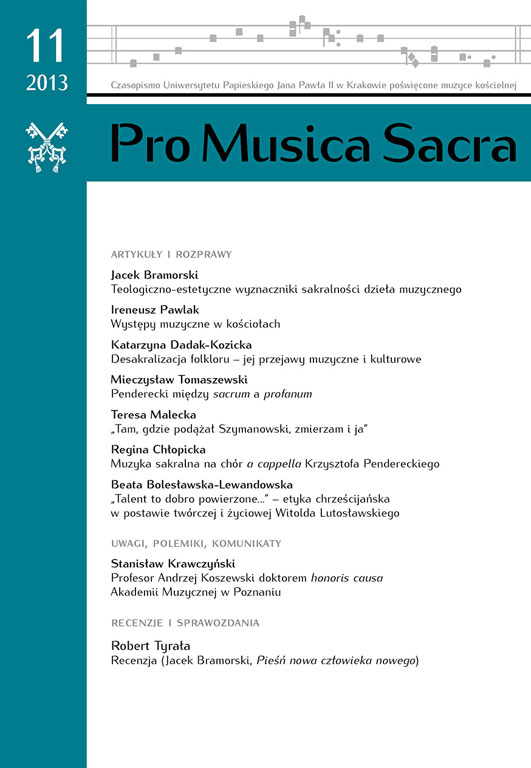Where Szymanowski went, I went too
DOI:
https://doi.org/10.15633/pms.558Keywords:
Karol Szymanowski, Henryk Mikołaj Górecki, history of Polish music, artistic activities, inspirations, intertextualityAbstract
There has been no greater contrast of personality, biography, worldview, and lifestyle. And yet there is no end to similarities, proximities, even kinship; great was Górecki’s fascination with Szymanowski.
First was the score of Beethoven’s Ninth, bought for the money earned by selling a ping-pong racket; but Górecki then spent his first savings on Chopin’s Impromptus and Szymanowski’s Mazurkas. He would recount later: “I still have these scores, and that is how my strange story begins: Beethoven’s Ninth Symphony, Chopin’s Impromptus and Szymanowski’s Mazurkas.”28 Yet apart from Górecki’s fascination with Szymanowski music and oeuvre, there is another link still. Both artists fell in love with Podhale, the Tatra Mountains and the culture of the region; so much that its main spa, Zakopane, became their second home. This went hand in hand with their fascination with the music of Podhale.
The focal point for Szymanowski’s impact on Górecki brings together two masterpieces of sacred music: Stabat Mater and Symphony of Sorrowful Songs.
Stabat Mater is one of Szymanowski’s few religious works; Górecki’s Sorrowful Songs are one of the many sacred works written both before and after the Symphony. Yet they are both instances of the highest artistry, of the apogee in their author’s creative achievements.
Outside explicit examples of correlation between the work of Szymanowski and Górecki, there is an analogy between them of a more general nature. Taking into account the historical situation in which the two composers lived and worked, and the meanders of Polish music of the 20th centuries, the stylistic breakthrough that took place both in Szymanowski – before his Stabat Mater – and in Górecki – before his Third Symphony – was of tantamount import to establish their rank and their position in the history of Polish music.
Downloads
Published
Issue
Section
License
Copyright (c) 2013 Teresa Malecka

This work is licensed under a Creative Commons Attribution 4.0 International License.
Authors who publish with this journal agree to the following terms:
- Authors retain the copyright and full publishing rights without restrictions, and grant the journal right of first publication with the work simultaneously licensed under a Creative Commons Attribution 4.0 International License that allows others to share the work with an acknowledgement of the work's authorship and initial publication in this journal.
- Authors are able to enter into separate, additional contractual arrangements for the non-exclusive distribution of the journal's published version of the work (e.g., post it to an institutional repository or publish it in a book), with an acknowledgement of its initial publication in this journal.
- Authors are permitted and encouraged to post their work online (e.g., in institutional repositories or on their website) prior to and during the submission process, as it can lead to productive exchanges, as well as earlier and greater citation of published work (See The Effect of Open Access).

